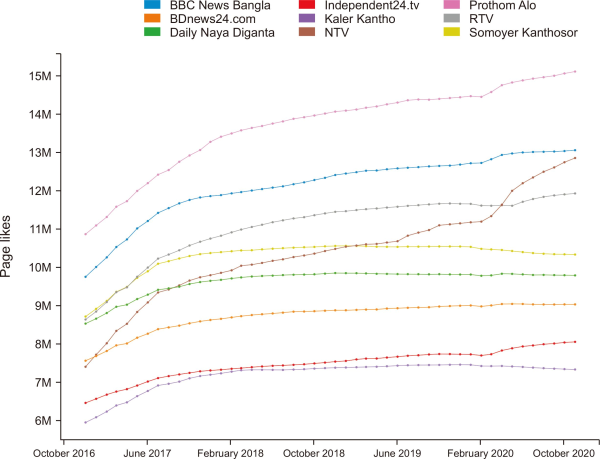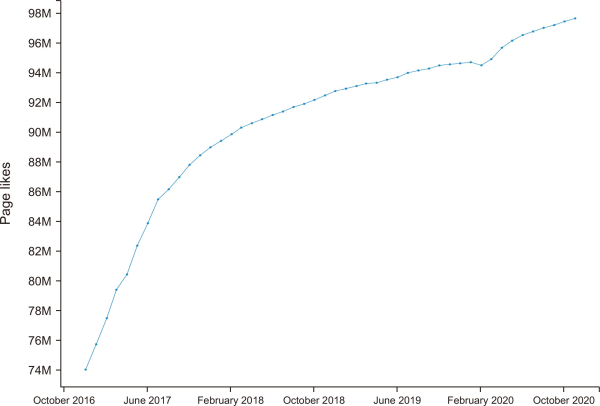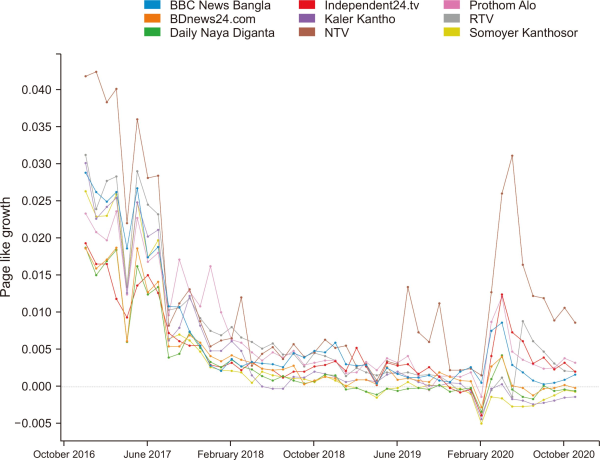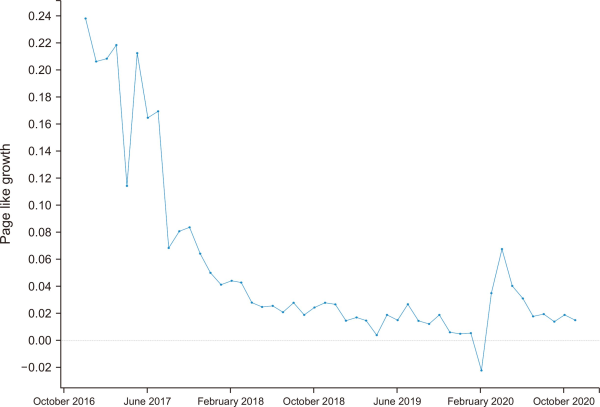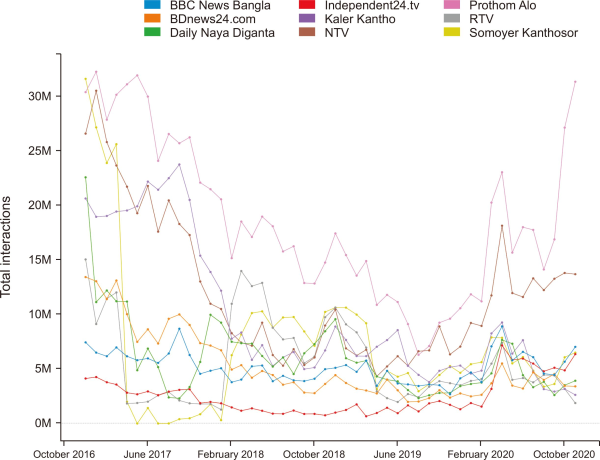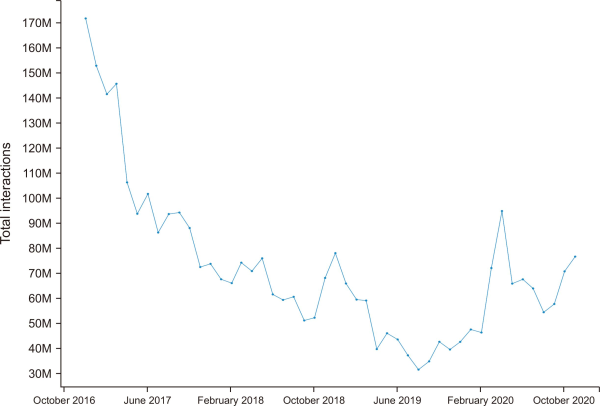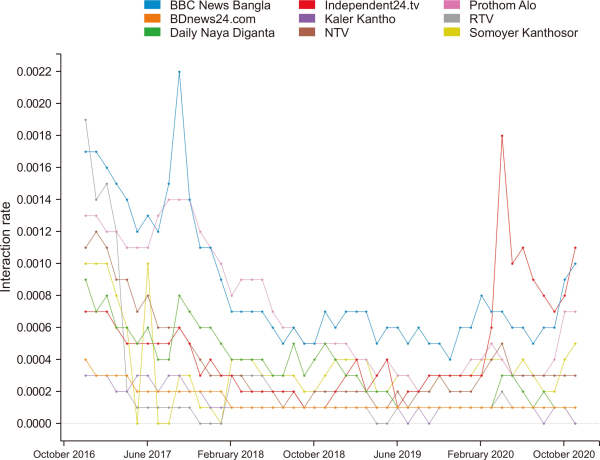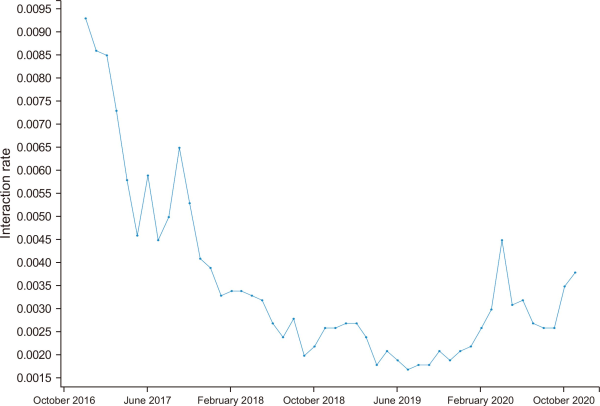JOURNAL OF INFORMATION SCIENCE THEORY AND PRACTICE
- P-ISSN2287-9099
- E-ISSN2287-4577
- SCOPUS, KCI

Social Media News in Crisis? Popularity Analysis of the Top Nine Facebook Pages of Bangladeshi News Media
Social Media News in Crisis? Popularity Analysis of the Top Nine Facebook Pages of Bangladeshi News Media

Mridha Md. Shiblee Noman (Department of Journalism and Media Studies, Jahangirnagar University, Savar, Dhaka, Bangladesh)

Abstract
Social media has become a popular source of information around the world. Previous studies explored different trends of social media news consumption. However, no studies have focused on Bangladesh to date, where social media penetration is very high in recent years. To fill this gap, this research aimed to understand its popularity trends during the period. For that reason, this work analyzes 97.67 million page likes and 3.48 billion interaction data collected from nine Bangladeshi news media’s Facebook pages between December 2016 to November 2020. The analysis shows that the growth rates of page likes and interaction rates declined during this period. It suggests that the media’s Facebook pages are gradually losing their popularity among Facebook users, which may have two more interpretations: Facebook’s aggregate appeal as a news source is decreasing to users, or Bangladeshi media’s appeal is eroding to Facebook users. These findings challenge the previous results, i.e., Facebook’s demand as a news source is increasing with time. We offer four explanations of the decreased popularity of Facebook’s news: information overload, exposure to incidental news, users’ selective exposure and different aims of using Facebook, and conflict between media agendas and users’ interests. Some theoretical and practical significance of the results has been discussed as well.
- keywords
- media organization, Facebook page, social media news, trend analysis, information, Bangladesh
1. INTRODUCTION
This study analyzed the popularity of news media outlets’ Facebook pages based on the historical trends of page likes and public engagement. The Internet has changed the existing ecology of news sharing and consumption: Social media platforms, such as Facebook and Twitter, are advancing it to a greater degree (Pentina & Tarafdar, 2014). This global shift in people’s information-seeking behavior has also brought a new challenge for the traditional media organizations (Bergström & Belfrage, 2018), because the increasing online news consumption is making them more dependent on social media (Hong, 2012; Lysak et al., 2012; Paulussen & Harder, 2014; Stassen, 2010). However, instead of undermining traditional media as some researchers believe, social media is reinforcing its capacity, extending its reach, and enabling multiplatform interaction (Chadwick, 2011; Hermida et al., 2012; Tewksbury & Rittenberg, 2012). In other words, both types of media are now converging and becoming interdependent (Dominick, 2009). In Bangladesh like elsewhere, mainstream media outlets are also relying on social media to produce and share their news items (Fahad, 2014). Thus, the increasing social media use is promoting the country’s news industry in some ways (Alam, 2020; Saiful & Park, 2019).
The social media penetration rate in Bangladesh has been high in recent years, and most of the social media users use Facebook (StatCounter, 2020). Facebook is a good source of news for many and its preference is increasing incessantly (Bene, 2017; Lampe et al., 2012; Shearer & Gottfried, 2017; Silver & Matthews, 2017). For that reason, most of the national media outlets in Bangladesh maintain their official Facebook page to promote news items and attract more audiences; it is an effective marketing strategy of the media outlets as well (Pletikosa Cvijikj & Michahelles, 2013). A study shows that a Facebook page of a media outlet can generate 33.9% to 58% of that media’s total engagement (Welbers & Opgenhaffen, 2018). Perceiving the benefits, media organizations usually share regular news updates, news links, breaking and attractive news stories, polls, and other interactive posts on their Facebook pages. In most cases, they share news stories that have social significance and public interest and stories that match the organization’s ideology and agenda (Al-Rawi, 2017). In this way, they often try to socialize with their followers as well.
Due to the lack of proper academic endeavor, however, it is still unknown what the popularity patterns of media Facebook pages are, and how their interaction trends change over time in Bangladesh. In practice, the news consumption pattern of Facebook users is still an emerging area of research worldwide; therefore it remains vastly unexplored (Pentina & Tarafdar, 2014). Also, previous studies only focused on Facebook’s popularity as an information source (Bene, 2017; Shearer & Gottfried, 2017; Silver & Matthews, 2017), the shift in people’s information-seeking behavior from offline to online (Hong, 2012; Lysak et al., 2012; Paulussen & Harder, 2014; Stassen, 2010), and changes in social media users’ news consumption and sharing behavior (Pentina & Tarafdar, 2014). These studies barely investigated and acknowledged the contributions of news media’s Facebook pages, and their public engagement and popularity trends. Moreover, the context of Bangladesh is largely ignored in the previous literature. Therefore, this research attempted to bridge the existing gap a little, contributing some insights to media and communication scholarship. Based on a research question, the present study seeks to understand the popularity growths of the nine selected news pages and the engagement growths of their posts. In the next section, some relevant concepts are discussed.
2. CONCEPTUAL FRAMEWORK
Information behavior is a relatively old field of research, which is now becoming more interested in exploring the information-seeking tendencies of online communities. In such explorations, researchers use a wide range of concepts; some of them are old, derived from the previous literature, while some are novel and yet to have a wide acceptance. We have discussed a few concepts below that are relevant to the present study.
2.1. Information Behavior Models
In information behavior research, some dominant models and concepts discussed why and how people seek, rely on, consume, and react to different information and information sources in different circumstances. The Information Seeking Behavior model proposed by James Kirkelas in 1983 was probably the first model of its kind that dealt with people’s information behavior (Rather & Ganaie, 2018). According to this model, people’s information behavior follows four steps: perceiving a need for information, searching for the available information to fulfill the need, finding the information, and using the information (Rather & Ganaie, 2018, p. 1415). Information needs can be divided into five categories: to meet the need for new information, to elucidate the information held, to confirm the information held, to elucidate beliefs and values held, and to confirm beliefs and values held (Wilson, 1997). Wilson in his information behavior model indicated three types of barriers in the information-seeking (searching and finding) process: personal barriers (emotional, educational, and demographic), social barriers (interpersonal and group relations), and environmental barriers (economic, source characteristics). These barriers may impact information utilization as well.
Interestingly, utilization of new information can satisfy or dissatisfy an information seeker, which may lead to further consequences. If a source can satisfy an information seeker with proper information, one assumption can be that the information seeker would prefer that source in future information-seeking; otherwise, not. In other words, if the source’s preference of information matches a seeker’s preference, their relationship should continue. It is important to note that every information source, such as newspapers and television, involves some specific preferences and intentions to achieve some goals (e.g., shaping opinion): We may call it an agenda. A source’s (media) primary agenda is to influence the information seeker (audience) to cause some changes (McCombs, 2013). On the other hand, an information seeker may also have some agendas. When agendas from both parties have more commonalities, as we have already suggested, an information seeker starts depending on that source for information. However, when both parties’ agendas contradict, an information seeker may move to some other available information sources. Studies found that information seekers’ and information sources’ agendas often differ (Schmidt et al., 2017). This can explain to some extent why some people prefer some certain information sources over others and why this behavior changes over time.
2.2. Information Overload & Selective Exposure
Information overload has been an important topic of interest to communication and information science scholars since the mid-twentieth century. However, the outset of social media and user-generated content has recently urged more research in this area, focusing mainly on online communication. Its main reason is the profuse production of digital information around the world every consecutive day. Information overload discusses a unique phenomenon: the dilemma of more information with limited information-processing capacities (Schick et al., 1990). Put simply, information overload is the situation in which an individual finds himself/herself with abundant information with a comparatively limited capacity to process and interact with this large amount of information. If we consider the case of social media, on one hand, every social media user is empowered to be information producers, who produce a large amount of information. On the other hand, users are the consumers of their self-produced information, making their cognitive information processing capacity exposed to such a large amount of information (Rodriguez et al., 2014). It creates an information overload situation for them.
In most cases, information overload leads to negative consequences, such as poor decision-making, exhaustion, change in information-seeking behavior, stress and tension, and so on (Fu et al., 2020; Schick et al., 1990). For example, Fu et al. (2020) in their study exploring three overloads (i.e., information overload, system failure overload, and social overload) argued that social media users become overloaded with information when automated information processing systems fail. Such information can be messages from friends, advertisements, or other third parties. When this information exceeds the information processing ability of the users, their feeling of social media exhaustion increases. Schick et al. (1990) argued that information overload in the organizational setup adversely impacts decision-making, management, and finance.
Rodriguez et al. (2014) modeled social media data to understand how and to what extent information overload impacts social media users. They found that the most active users suffer the most from information overload. In practice, social media users’ ability to process information is limited and relies on the rate at which they receive information (Rodriguez et al., 2014, p. 179). They also found that “an exposure to a piece of information, be it an idea, a convention or a product is much less effective for users that receive information at higher rates, meaning they need more exposures to adopt a particular contagion” (Rodriguez et al., 2014, p. 170). There is a relationship between the overloaded users and their source preferences. Users’ limited attention is divided among information, which is subject to change. When a user is overloaded, (s)he tends to prioritize a smaller number of information sources, mainly based on their reliability, ideological proximity, imitation, and so on (Rodriguez et al., 2014). Therefore, in terms of news sources, it is normal for users to prioritize a few sources over others, and their tastes may change over time based on several factors.
Other studies investigated the relationship between different demographic variables with news overload, and its impact on them. For example, Holton and Chyi (2012) noted that gender is positively correlated with news overload and females are more vulnerable to such overload. They also found that news interest is negatively associated with overload, meaning news overload is less prevalent when users choose news according to their personal preferences (Holton & Chyi, 2012). Put another way, when users face the situation of information overload, they tend to prioritize their personal choice of news and source selection. A study with similar findings explored the phenomena that when users perceive themselves as overloaded with information, they selectively expose themselves to limited and certain information sources based on their trust and the sources’ reliability (Lee et al., 2017). In contrast, users with a lower level of information overload frequently access different sources of information. The overloaded users also temporarily avoid some news sources to resolve their problem with processing large amounts of information. This could be a reason for some news sources’ fluctuating popularity and interaction trends over time.
Studies also found that users’ preferences of news sources are intentional and selective, producing a community structure among a few media outlets (Schmidt et al., 2017). They often purposefully filter the news sources and items that do not match their interests (Lee et al., 2017). Also, they do not interact with many sources for a long time; rather, they change their preferences often: They only interact for a long time with very few sources dominated by their selective exposure. This further explains the fluctuations of information sources’ popularity.
2.3. Incidental News
Consumption of incidental news is commonplace in social media and for social media users. Algorithms of platforms, advertisements, and promotions could be its main reasons. However, incidental news is a pre-digital phenomenon that gains new momentum in contemporary times. It simply denotes the idea of an individual’s unintentional exposure to information or news. Around 74% of users aged under 29 years encounter incidental news when they surf social media, a survey found; another survey found 29% of users encounter incidental news while using social media for some other reason (Boczkowski et al., 2018). These findings indicate that for social media users unwarranted and incidental news is not uncommon even when it is unwanted. However, in many cases, users become interested in the news and pay a visit to it, which increases the reach and interaction of that news item (Boczkowski et al., 2018). On the contrary, it may also prevent many users from visiting the sources of unwanted news. For example, in a study conducted by Boczkowski et al. (2018) in Argentina, an interviewee stated that he does not consume incidental news because it will be popping up often afterward, perhaps due to algorithms. These two contrasting actions and perspectives may explain some information sources’ interaction fluctuations from time to time. In relation to these findings, another study on incidental news claimed that social media users constantly get incidental news if they spend significant time on the Internet (Boczkowski et al., 2017). Sometimes it becomes indistinguishable from other usual contents, so many users access that information sporadically and engage with it superficially.
3. MATERIALS & METHODS
3.1. Research Question
The previous research is limited in at least three ways. First, it did not focus on the context of Bangladesh or consider its unique social media environment and its users’ information-seeking behavior. Second, historical trends in information seeking from social media pages did not receive proper attention. Third, multivariable popularity analysis of Facebook information sources (e.g., Facebook pages) is absent. Considering these limitations, this study endeavored to understand the popularity of social media news in Bangladesh based on historical trends of the selected media organizations’ official Facebook pages. The following research question guided the data collection and analysis of this study.
Since there was hardly any relevant study in this specific area to guide our analysis and/or study framework, we had to determine our own way of dealing with the question. Regarding the research question, we measured the popularity of a Facebook page based on two variables: the page’s number of followers, and engagement of the posts. Put simply, the first variable indicates how popular a page is, and the second variable indicates how popular the page’s posts are.
3.2. Data Source
We selected Facebook for our analysis because of its unparalleled popularity (95%) in Bangladesh compared to other social media platforms, such as Twitter (0.35%) and YouTube (2.73%) (StatCounter, 2020). We selected the top nine Facebook pages based on their numbers of followers on 17 December 2020, based on the insights from Socialbakers ( http://socialbakers.com), an international social media marketing company. Our selected pages were Prothom Alo, BBC News Bangla, NTV, RTV, Somoyer Kanthosor, Daily Naya Diganta, BDnews24.com, Independent24.tv, and Kaler Kantho (Table 1). Of the selected media outlets, three were newspapers, three were television channels, and three were online news portals. We set the data collection period from 1 December 2016 to 30 November 2020, a total of four years with one-month intervals.
Table 1
Basic descriptions of the media samples
| Page name | Media type | Website link | Page likea) | Page link (fb.com/) |
|---|---|---|---|---|
| Prothom Alo | Newspaper | http://prothomalo.com | 15.12 | /DailyProthomAlo |
| BBC News Bangla | Online news portal | http://bbc.com/bengali | 13.08 | /BBCBengaliService |
| NTV | Television channel | http://ntvbd.com | 12.88 | /ntvdigital |
| RTV | Television channel | http://rtvonline.com | 11.95 | /rtvonline |
| Somoyer Kanthosor | Online news portal | http://somoyerkonthosor.com | 10.35 | /somoyerkonthosor |
| Daily Naya Diganta | Newspaper | https://dailynayadiganta.com | 9.81 | /nayadiganta |
| BDnews24.com | Online news portal | http://bdnews24.com | 9.05 | /bdnews24 |
| Independent24.tv | Television channel | http://independent24.com | 8.08 | /IndependentTVNews |
| Kaler Kantho | Newspaper | http://kalerkantho.com | 7.35 | /kalerkantho |
a)The data (in millions) were collected from Socialbakers ( http://socialbakers.com) on 17 December 2020.
3.3. Data Type & Measurement
Two types of data were collected based on the research question: page popularity data and post engagement data. The first type of data included total page likes during the period, page likes after a regular interval, and page-like growth rates over the period. The second type of data included total interactions of the pages during the period, interactions after a regular interval, and interaction growth rates over the period. The first type of data represents the pages’ reach and popularity to its audiences, and it is measured based on the number of likes of that particular Facebook page. The second one represents the posts’ reach and popularity to their audiences, and it is measured based on the number of comments, reactions, and shares each post generates. These two types of variables are the indicators of a page’s popularity among users (Schmidt et al., 2017). Six categories of posts were included in the interaction analysis: photos, links, statuses, Facebook videos, Facebook likes, and embedded (mostly YouTube) videos shared on Facebook. Interaction types were measured based on reactions, comments, and shares. Note that we excluded branded content from the count because of its financial endeavor.
3.4. Data Collection & Analysis
We extracted the data in CSV format using CrowdTangle, a public insights tool owned and operated by Facebook. While collecting the data based on the discussed parameters, we also used the following built-in filters in CrowdTangle: We set the language to Bengali, country of the page to Bangladesh, the data source to Facebook Page, and post type to All. After data extraction, we converted the CSV file into Microsoft Excel and cleaned and prepared the data for the final analysis. The combined likes of the nine pages during the selected period were 97.67 million (mean [M]=10.85, standard deviation [SD]=2.58) and interactions were 3.48 billion (B) (M=386.87, SD=232.78). Also, the total number of posts was 1.51 million (M=0.17, SD=0.16), with monthly 3,472 posts on average and 2,321 interactions per post. We used line graphs for a simple time-series analysis of page likes and their growth, and interactions and their growth over the period to understand the selected pages’ popularity trends throughout the time. The statistical analysis was conducted in IBM SPSS Statistics 25 (IBM Co., Armonk, NY, USA), and the visualizations were produced using Tableau 2020.4 (Tableau Software, Seattle, WA, USA), a professional data visualization software.
4. RESULTS
4.1. Page Like Analysis
During the period, the Prothom Alo Facebook page had the highest number of followers (n=15.13M; 15.49%), followed by BBC News Bangla (n=13.08M; 13.39%) and NTV (n=12.87M; 13.18%); Kaler Kantho (n=7.35M; 7.53%) was on the bottom of the list, followed by Independent24.tv (n=8.08M; 8.27%) and BDnews24.com (n=9.05M; 9.27%) (Table 2). Although NTV had the third-highest number of followers, it earned the highest page likes (n=5.45M; 73.39%), followed by Prothom Alo (n=4.25M; 39%) and RTV (n=3.29M; 38%).
Table 2
Indicators of page popularity
| Page name | Total likesa) | Percentage | Like growtha) | Like growth (%) |
|---|---|---|---|---|
| Prothom Alo | 15.13 | 15.49 | 4.25 | 39.00 |
| BBC News Bangla | 13.08 | 13.39 | 3.31 | 33.82 |
| NTV | 12.87 | 13.18 | 5.45 | 73.39 |
| RTV | 11.95 | 12.24 | 3.29 | 38.00 |
| Somoyer Kanthosor | 10.35 | 10.60 | 1.62 | 18.53 |
| Daily Naya Diganta | 9.81 | 10.04 | 1.26 | 14.72 |
| BDnews24.com | 9.05 | 9.27 | 1.47 | 19.39 |
| Independent24.tv | 8.08 | 8.27 | 1.59 | 24.60 |
| Kaler Kantho | 7.35 | 7.53 | 1.38 | 23.16 |
Fig. 1 shows the changes in likes of individual pages during the period. Prothom Alo remained in the highest position with 10.89M likes in December 2016, followed by BBC News Bangla (n=9.77M) and Somoyer Kanthosor (n=8.74M); RTV (n=9.77M) overtook Somoyer Kanthosor (n=9.75M) in May 2017. The combined page likes increased from 74.06M in December 2016 to 97.68M in November 2020. However, the line of the page like in Fig. 2 shows an uneven growth: The line was steady from July 2017 to January 2020. The combined page likes again started to increase after a fall in February 2020. Overall, the combined page likes increased by 31.62% (n=23.61M) from December 2016 to November 2020.
The individual lines of growth rate show regular fluctuations from the very beginning. However, most of the lines were comparatively steadier from August 2017 to January 2020. While other lines were maintaining a rhythm, NTV (3.12%) experienced a remarkable surge in May 2020 before dropping again in the subsequent months (Fig. 3). The line of combined page-like growth rate shows a few heavy fluctuations from March to August 2017, and a steady drop from October 2017 to January 2020, with the largest drop in the next month (Fig. 4). The growth rate increased a little in March and April 2020 and again dropped in the following months. Afterward, the combined growth rate of page likes started to slowly increase again but with regular fluctuations. Although the combined page likes increased, the combined growth rate dropped by 93.56% (0.2236) during this period. A Pearson correlation coefficient analysis of the four years’ data shows an almost perfect negative correlation between the combined page likes and page-like growth rate (r=-0.905) with p<0.01, which is statistically significant.
4.2. Interaction Analysis
Table 3 shows the basic descriptions of the interaction indicators. Prothom Alo (n=897.4M) had the highest interactions during the period, followed by NTV (n=574.77M) and Kaler Kantho (n=473.11M), and Independent24.tv (n=122.56M) had the lowest. In terms of the number of posts, Kaler Kantho (n=0.56M; 37.24%) was on the top of the list, followed by BDnews24.com (n=0.22M; 14.52%) and RTV (n=0.20M; 13.53%), and BBC News Bangla (n=0.03M; 1.78%) was on the bottom. On the other hand, BBC News Bangla (n=9,345) had the highest interactions per post, followed by Prothom Alo (n=8,413) and Independenet24.tv (n=3,400), and Kaler Kantho (n=847) had the lowest. The data show that though Kaler Kantho had the highest number of posts, its interactions per post were the lowest of all.
Table 3
Indicators of page interactions
| Page name | Total interactionsa) | Total postsa) | Percentage | Interactions per post | Cumulative interaction (%) | Average interaction (%) |
|---|---|---|---|---|---|---|
| Prothom Alo | 897.4 | 0.11 | 7.11 | 8,413 | 91.84 | 0.07 |
| NTV | 574.77 | 0.16 | 10.71 | 3,579 | 42.17 | 0.04 |
| Kaler Kantho | 473.11 | 0.56 | 37.24 | 847 | -97.26 | 0.01 |
| Somoyer Kanthosor | 346.45 | 0.09 | 5.90 | 3,913 | 9,832.05 | 0.04 |
| Daily Naya Diganta | 289.96 | 0.10 | 6.81 | 2,840 | 38.48 | 0.03 |
| RTV | 273.19 | 0.20 | 13.53 | 1,346 | 592.29 | 0.02 |
| BDnews24.com | 255.19 | 0.22 | 14.52 | 1,172 | -26.46 | 0.01 |
| BBC News Bangla | 249.17 | 0.03 | 1.78 | 9,345 | 115.60 | 0.08 |
| Independent24.tv | 122.56 | 0.04 | 2.40 | 3,400 | 297.73 | 0.05 |
Most of the individual interaction lines show random fluctuations throughout time. For example, Prothom Alo, the highest interactive page, had 30.47M interactions in December 2016, dropping to 27.93M in February 2017 and surging again after August 2020 (Fig. 5). After several fluctuations, it reached 31.42M interactions in November 2020, which was its highest. Like Prothom Alo, Independent24.tv also experienced an overall increase in interactions: from 4.14M in December 2016 to 6.38M in November 2020. However, unlike these two pages, the interactions of the other seven pages show an overall downward trend with several fluctuations: The total interactions for all pages decreased from 172.28M in December 2016 to 76.95M in November 2020. The pages’ combined interaction line shows a fluctuating tendency as well. The line went downward from December 2016 to August 2019 with several ups and downs in regular intervals (Fig. 6). The combined interactions experienced an irregular upward trend afterward until November 2020. Overall, during this period, the combined interactions dropped by 55.33% (n=95.32M).
Fig. 7 shows the uneven interaction growth rates of individual pages during the period, which somewhat resembles their interaction lines. Interactions of BBC News Bangla remained the highest for most of the time, followed by Prothom Alo, and both experienced several drops in their interaction rates before a gradual rise after September 2020. Interestingly, the overall interaction growth rates of all pages except Independent24.tv were lower in November 2020 than in December 2016: BBC News Bangla from 0.17% to 0.10%, Prothom Alo from 0.13% to 0.07%, RTV from 0.19% to 0%, NTV from 0.11% to 0.03%, BDnews24.com from 0.04% to 0.01%, Kaler Kantho from 0.03% to 0%, and Daily Naya Diganta from 0.09% to 0.01%. However, the interaction rate for Independent24.tv increased from 0.07% in December 2016 to 0.11% in November 2020, with a huge surge (0.18%) in April 2020. After a year of several fluxes, the line of combined interaction growth rate became steadier from January 2018 to March 2020 (Fig. 8). Overall, the combined interaction growth rate dropped by 59.14% (0.0055) from December 2016 to November 2020. A Pearson correlation coefficient test shows almost a perfect positive correlation between the combined interactions and interaction growth rate (r=0.967) with p<0.01, which is statistically significant.
5. DISCUSSION & CONCLUSION
This study aimed at understanding the popularity trends of the top nine Facebook pages of Bangladeshi media. Based on the historical data ranging between December 2016 to November 2020, we analyzed the page likes, like growth, total interactions, and interaction growth to answer the research question.
5.1. Key Findings
This study has two key findings. First, the combined likes of the media’s Facebook pages increased, but their page-like growth rates dropped. Also, the growth of combined page likes became comparatively steadier compared to two years ago, and the page growth rate had a downward tendency at the end of the period. If both trends continue, after a certain time the combined page likes will be dropping instead of increasing. This result also infers that most of the media pages are failing to attract more Facebook users in recent times. It is possible that the number of Facebook users does not always increase at the same rate, so the numbers of page-likes may not also increase at the same rate. However, it can also be considered that although the page-likes fluctuated throughout the period, the number of Facebook users was likely to increase (Kemp, 2020). Second, both the pages’ combined interactions and interaction growth rates dropped, although, based on their previous (oscillating) trends, there is a possibility that both numbers could increase again in the future. The results indicate that Facebook users are becoming less interested not only in the media’s Facebook pages but also in the contents they share on their pages. However, some pages may be exceptional, generating more interactions, although such instances are insignificant. Overall, the findings suggest that the Bangladeshi media’s Facebook pages are perhaps gradually losing their popularity among Facebook users with their reduced user engagement. This may also be interpreted in two other ways: Facebook’s aggregate appeal as a news source is decreasing to its users, or Bangladeshi media outlets are losing their appeal to Facebook users. Note that this study analyzed Facebook pages of three different types of media outlets: television channels, newspapers, and online news portals. Interestingly, the popularity trends are almost identical for all types of media, showing no exceptional pattern. It suggests that Facebook users do not differentiate between media outlets while consuming news.
Previous studies demonstrated Facebook’s importance as an information source (Bene, 2017; Silver & Matthews, 2017). A few studies also found that Facebook’s popularity as a news source is increasing, which means more people are consuming news from Facebook nowadays (Lampe et al., 2012; Shearer & Gottfried, 2017). However, the present findings contradict the previous studies. This may have a few reasons: The data of previous studies were collected mainly from users through a survey or interview, which may have represented a partial picture of the scenario; the previous results were time-specific and temporal; the studies did not consider Facebook’s historical data. Considering these limitations of the literature, this study tried to provide more updated and reliable insights into the news consumption behavior of Facebook users, analyzing a large amount of historical and multifaceted public engagement data.
A range of factors can influence Facebook users’ news consumption and information-seeking behavior. For example, bandwidth, location of the user, and the user’s demographics (e.g., age, income, and education), according to Nguyen (2003), may influence online news consumption. On the other hand, Mishra and Bakshi (2017) identified four factors: credibility, ideology, entertainment, and localization of the news, that influence people’s news consumption behavior. In the context of Bangladesh, Hasan and Mohua (2020) found that a user’s education level, interest level, and trust in the source mostly influence user news consumption behavior. However, we presume that the discussed factors are inappropriate and/or inapplicable in the present context. Therefore, we presume that the following four factors could be responsible for Facebook’s decreased popularity as a news source: information overload, exposure to incidental news, users’ selective exposure and different aims of using Facebook, and conflict between the media’s agenda and users’ interest.
First, excessive news sharing tendency can be responsible for some pages’ decreasing interaction rates. Facebook users’ personal and collective preferences determine their news taste, and they may not find more news desirable. Therefore, unimportant information may lead to information overload, which has negative impacts on users’ relations to that media (Holton & Chyi, 2012). When users find themselves in an information-overflowed situation, they start to selectively expose themselves to specific Facebook posts, avoiding some overflowed sources (Lee et al., 2017; Pentina & Tarafdar, 2014). For example, Kaler Kantho shared the highest number of posts with a reducing interaction rate, whereas BBC News Bangla’s interaction growth rate line remained higher with the lowest number of posts. It suggests that users may consume less news from a page with more news, of which most might be unimportant to them. Moreover, a user may also feel information overload thanks to multiplatform news consumption. The Bangladeshi media industry has experienced three consecutive advancements in print, broadcast, and online media in the 1990s, 2000s, and 2010s, respectively (Haider & Samin, 2014). In September 2020, 126 online news media outlets received clearance through a government-enacted registration process (Dhaka Tribune, 2020). However, in practice, the number of unofficial and low-quality online media outlets is much higher than the officially-certified outlets, and they tend to promote copy-paste journalism instead of intellectual or professional journalism. Most of such outlets usually operate their own Facebook pages to attract more audiences, providing copy-pasted, sensational, unimportant, and clickbait news items (Ercegovac & Sredojević, 2014; Mansurova, 2014). Thus, Facebook users could be affected by redundant news items that may cause information overload as well.
Second, the fluctuations in interactions could be a reason for users’ exposure to incidental news, which is a common phenomenon on Facebook due to its algorithms (Boczkowski et al., 2018). Young users interact more with such types of content (Boczkowski et al., 2017). Interestingly, according to Socialbakers, the largest share of Bangladeshi Facebook users is young, aged between 18 to 24. It implies that they could be frequently exposed to incidental news, which defines the fluctuations in pages’ interaction and growth rates. Important to note is that users are not always likely to or interested in interacting with incidental news. Rather, their engagement depends on a few factors, such as prior knowledge and interest (Karnowski et al., 2017).
Third, users’ preferences and exposure to news are selective (Schmidt et al., 2017) and they often filter out information and avoid information sources that do not match their interests (Lee et al., 2017). Both tendencies explain the increasing and decreasing popularity and interaction rates of different pages. Interestingly, studies also found that the primary reason for many users’ Facebook use may not be accessing or seeking news or important information (Bergström & Belfrage, 2018). Rather, they use it to belong and to self-represent: The first goal is an “intrinsic drive to affiliate with others and gains social acceptance,” and the second one is a technique of impression management (Nadkarni & Hofmann, 2012, p. 5). This suggests a possibility that the primary concern of Bangladeshi Facebook users is something other than accessing news or news-related content. Though it may define the gradual drop in page likes and interactions, it may not properly explain their irregular fluctuations.
Fourth, the conflicting ideals between the media’s agenda and news consumers’ interests could be another reason for some pages’ decreased popularity (Rather & Ganaie, 2018; Wilson, 1997). We have already explained that users’ news preferences are highly motivated by their personal interests and agendas. On the other hand, every media organization has certain agendas that shape its shared contents. Media interests and user preferences could contradict, which may shift users to another news source, reducing the popularity of that particular Facebook page (Schmidt et al., 2017). Bangladeshi media outlets have a few common criticisms: Due to competition in the media industry, some of them often sensationalize or exaggerate a simple news event; some create misperception among the public instead of being an honest watchdog; some are oblivious about their social responsibility and apathetic about public criticisms (Rahman, 2016). For these reasons, Haider and Samin (2014) have termed Bangladeshi media as “mass alienated media.” On the other hand, a large number of (online) media outlets produce and spread fake news, deceiving potential news consumers instead of supplying reliable news (Al-Zaman et al., 2020); this hurts news consumers’ reputations (Altay et al., 2020). Due to users’ lower information and/or digital literacy levels, many of them are also unaware of quality news and information ethics: what types of news they should consume from which sources, what they should expect from the professional media outlets, and which content can be shared publicly or not.
It could be possible that users are only losing interest in the media’s Facebook pages, to be specific. This means Facebook’s demand as a news source is not at risk, rather more users seek news from other personalized online sources, such as online opinion leaders, other than the media’s Facebook pages (Bergström & Belfrage, 2018; Bodendorf & Kaiser, 2009). If this is the case, media outlets should be worried about it. As stated earlier, Bangladesh’s mainstream media outlets are becoming more dependent on social media; they try to capitalize their Facebook pages to attract more audiences and generate more interactions (Fahad, 2014), and Facebook pages help to produce more of the media’s followers (Welbers & Opgenhaffen, 2018). In such circumstances, the decreasing popularity of media Facebook pages and their shared contents is alarming. Therefore, for their business to survive, and for their reputation and public reach, they must understand users’ motivations and interests, and their news-seeking and consumption behavior.
5.2. Strengths and Limitations
This research has a few limitations. First, the data for this research were collected using CrowdTangle, that relies on automation. For that reason, the data could not be cross-checked manually during and after the collection period to find out whether there is any missing or corrupted data. For example, the dataset shows that the Somoyer Kanthosor page did not post anything in May and July 2017, and it could not be verified. However, there could be some other issues as well that can explain this, such as page inactivity and temporary blocks. Second, this study drew inferences only based on visible users’ interaction data, excluding silent users or lurkers, who could be active information consumers but produce no digital trace (Benevenuto et al., 2009; Gong et al., 2015). Third, the correlation coefficient analysis between the like counts of the pages and their growth rates showed a negative correlation for the four years’ data, which may not explain the real tendency. Therefore, this finding demands further study with an extended time span for a more acceptable and generalizable result.
Besides these limitations, this study has four major strengths. First, academic endeavors to understand different media outlets’ popularity and public engagement in social media platforms was limited. In this gap, the present study offered some insights. Second, this study analyzed a larger dataset compared to the previous studies (e.g., Bene, 2017; Lampe et al., 2012; Silver & Matthews, 2017) to explore the news media’s online interactions. From this aspect, the present results could be more reliable and inclusive. Third, little was explored about online news consumption in Bangladesh to date based on historical popularity data. Fourth, these findings can provide some insights to media managers regarding the overall climate of Facebook news consumption, which would help them to come up with a more effective plan to increase more public participation in their Facebook pages. More future research should focus on the news consumption patterns of the heterogenous Facebook users of Bangladesh to comprehend their underlying predispositions.
REFERENCES
, , , , , (2020) Social media rumors in Bangladesh Journal of Information Science Theory and Practice, 8(3), 77-90 https://doi.org/10.1633/JISTaP.2020.8.3.6.
Dhaka TribuneDhaka Tribune, 2020, Dhaka Tribune, 91 other newspapers, get permission to register websites, https://www.dhakatribune.com/bangladesh/2020/09/04/dt-91-other-newspaper-portals-get-permission-to-register
(2014) The emergence and impact of social media on the mainstream journalism in Bangladesh Jahangirnagar University Journal of Journalism and Media Studies, 1 https://jmsju.com/archives/697.
(2020) Digital 2020: Bangladesh https://datareportal.com/reports/digital-2020-bangaldesh
, , , , (2014, June 1-4) Proceedings of the 8th International AAAI Conference on Weblogs and Social Media University of Michigan Quantifying information overload in social media and its impact on social contagions, 170-179, https://ojs.aaai.org/index.php/ICWSM/article/view/14549
, (2019) A study on the integration of UGC in broadcast journalism: An evidence from Bangladesh Journal of Digital Convergence, 17(1), 301-311 https://doi.org/10.14400/JDC.2019.17.1.301.
, (2017) News use across social media platforms 2017 https://www.journalism.org/2017/09/07/news-use-across-social-media-platforms-2017
StatCounter (2020) Social media stats Bangladesh http://gs.statcounter.com/social-media-stats/all/bangladesh
- 투고일Submission Date
- 2021-05-21
- 수정일Revised Date
- 2021-05-30
- 게재확정일Accepted Date
- 2021-05-31
- 599다운로드 수
- 2,021조회수
- 0KCI 피인용수
- 0WOS 피인용수

